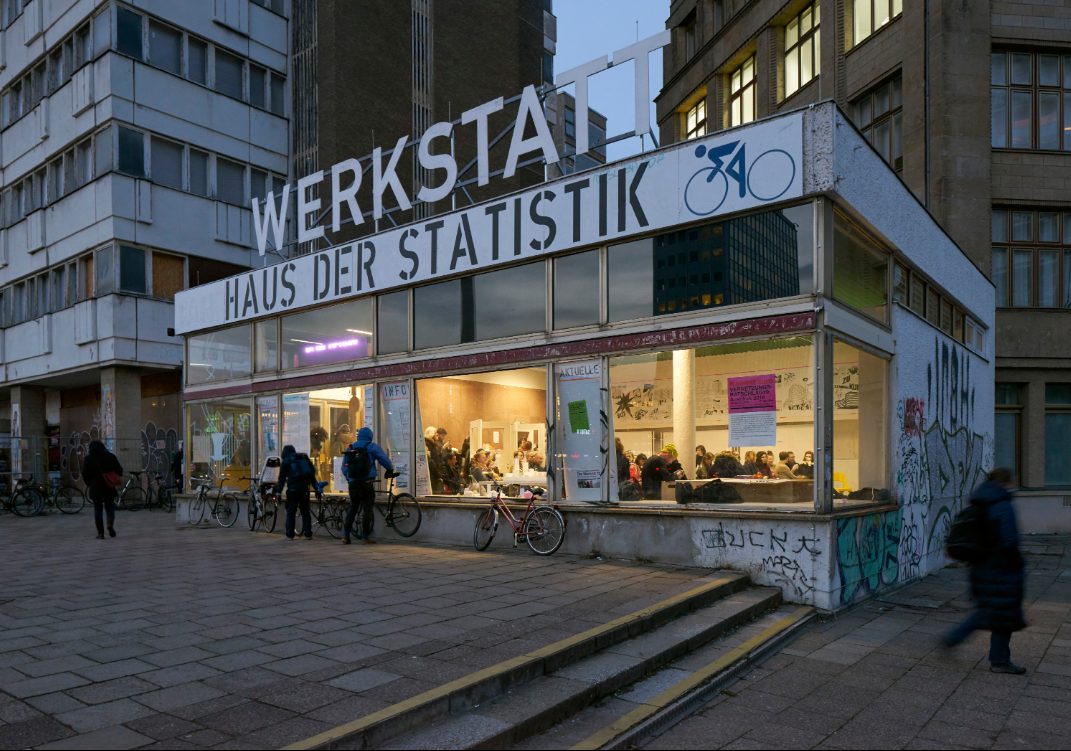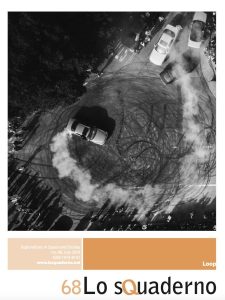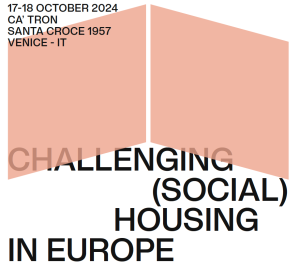Due to its troubled history as a divided city, Berlin is an urban patchwork of modern tendencies and vestiges of the past. The Haus der Statistik (HdS) is one of such remains of Germany’s recent socialist experience. In the shadow of the lively Alexanderplatz, the complex of four buildings designated as the headquarters for the administration of statistics under the GDR has remained forgotten for nearly a decade. While federal authorities in post-Unification Germany kept using HdS spaces (covering an area of 46,000 square meters), the buildings were dismissed in 2008 and were left in a state of abandonment until 2015, when they were suddenly shot back at the center of public attention, framed as the symbol of a broader struggle for the right to the city.
The initiative Haus der Statistik, launched to convert those former public offices into fruitful spaces at the disposal of artists, locals, and refugees, was triggered by the willingness to save the historical complex from the neo-liberal grip of privatization. In fact, to alleviate the economic debt, publicly-owned buildings all over the German capital have, since the early 2000s, been sold unconditionally to the highest bidder, neglecting any principle of common good and civic engagement during the procedure of relocating the ownership of such properties. This practice resulted in a redefinition of the city center as a commercially oriented hub.
Exploiting the immediate contingencies that came to form in 2015, a group of artists united under the Alliance of Threatened Berlin Studio Houses (AbBA) started to take collective action against the selling and demolition of the HdS. More specifically, they successfully aligned the issue surrounding this specific case to wider collective claims that were already pressuring for the regeneration of adequate spaces reserved for cultural, educational, and social activities dedicated to the city and its inhabitants. Soon, an action of symbolic protest evolved into an unprecedented collaboration, drawing support from a heterogeneous network of professionals and activists. The latter has been gradually institutionalized in the so-called Koop-5, which includes both state actors and public stakeholders (the Senate administration, the Berlin Mitte district administration, WBM, and BIM state firms) and civic society partners, such as artists, architects, and researchers (represented by the legally recognized ZUsammenKUNFT cooperative, formed in 2016).
The negotiation of the HdS large-scale project brought about a professionalization of what are usually considered bottom-up dynamics characterizing the right-to-the-city movement. This format was met with positive responses by the political and administrative authorities of Berlin, who agreed upon the need to overcome the urban crisis and rethink property policies by starting from the close observation of people’s living needs and by respecting standards of urban development, long-term sustainability, and social inclusion. The model proposal for the regenerated HdS unfolds throughout multiple layers and touches upon several objectives: for instance, the proper economic functioning of the buildings, or the foundation of an Academy of ZUsammenKUNFT – that takes care of fostering discussion of key themes of migration, urban and housing developments, culture. Moreover, pilot projects oriented towards the common good are being gradually developed. The fil rouge running through such different levels is the collective and participatory approach underpinning discussion, research, and creative activities pursued within the Haus der Statistik initiative, which must be understood as a communal process of inclusive urban planning. Inclusivity means opening up multifarious channels of communication and exchange of ideas between professionals and the neighborhood, offering specialized knowledge to local appropriations, and embedding specialized knowledge within local needs.
Tesserae is closely following the evolution of the initiative and its projects.
Further information can be found:
ZK/U section on Haus der Statistik
ZUsammenKUNFT Initiative Website
Article on the story and development of the Haus der Statistik project


